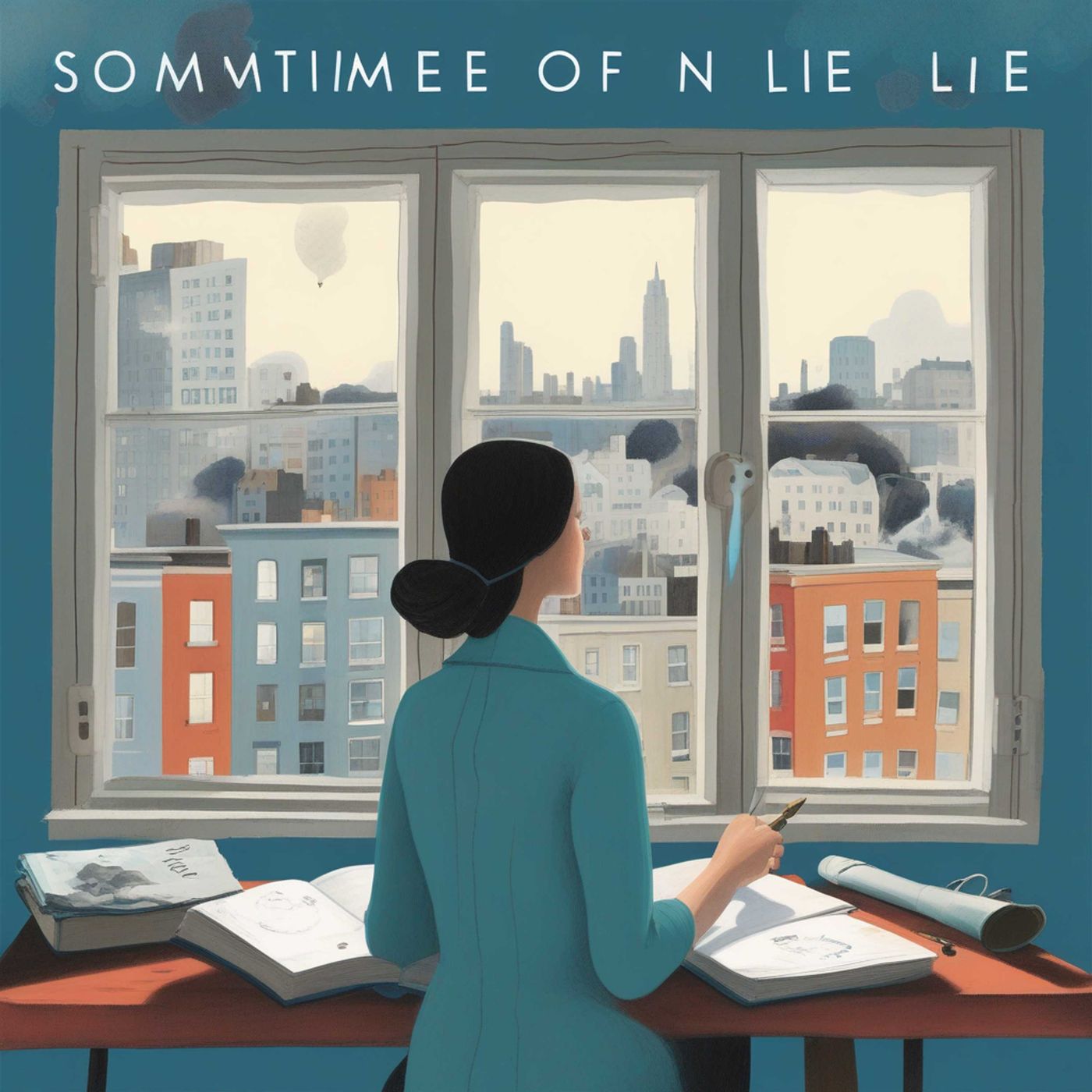Discover Bookey Summary
Bookey Summary

Bookey Summary
Author: Bookey
Subscribed: 6Played: 159Subscribe
Share
© Bookey
Description
Bookey: Unlock big ideas from bestsellers in 30 mins audio, text, and mind map
https://www.bookey.app/
Bookey summarizes the key ideas of world’s bestselling books in 30-minute audio clips and text transcripts. Each book is complemented with a mind map that highlights the essence of the book, allowing users to grasp the gist of the book at a glance.
1.Learning with no limits
2.Get more in less time
3.Download mode
4.Inspired with mind map
https://www.bookey.app/
Bookey summarizes the key ideas of world’s bestselling books in 30-minute audio clips and text transcripts. Each book is complemented with a mind map that highlights the essence of the book, allowing users to grasp the gist of the book at a glance.
1.Learning with no limits
2.Get more in less time
3.Download mode
4.Inspired with mind map
924 Episodes
Reverse
1 What's Lock Every DoorIn "Lock Every Door" by Riley Sager, the overarching theme revolves around the exploration of trust, obsession, and the hidden darkness within seemingly perfect facades. The story follows Jules, a young woman who takes a job as an apartment sitter in a luxurious building with strict rules and a mysterious history. As she delves deeper into the building's secrets and the lives of its eccentric residents, she uncovers a web of deception, danger, and sinister pasts, ultimately leading her to confront her own fears and the nature of loyalty. The novel blends elements of psychological thriller and horror, creating an atmosphere of suspense that keeps readers on edge as secrets unfold.2 Key Concepts of Lock Every DoorIn Chapter 1 of "Lock Every Door" by Riley Sager, the theme of isolation and the eerie feeling of being watched is introduced through the protagonist's new job as a apartment sitter in a mysterious building. This theme recurs profoundly in Chapters 3, 5, and 12, where the protagonist's sense of isolation deepens as she explores the haunted history of the building, meets other residents, and begins to discover unsettling secrets that heighten her feelings of being trapped and observed. As the narrative progresses, these chapters explore the psychological toll of isolation, drawing parallels between her physical surroundings and her emotional state.3 In-Depth Chapter Analysis of Lock Every Door by Riley SagerIn "Lock Every Door" by Riley Sager, we see a significant progression of themes revolving around trust, isolation, and the impact of past traumas, particularly through Chapters 1, 9, and 19. In Chapter 1, the protagonist, Jules Larsen, is introduced to the enigmatic complexities of the Bartholomew—a luxurious yet foreboding apartment building. Her initial excitement about her new job as an overnight sitter is palpable; however, it foreshadows a deepening tension as she begins to unravel the building's dark secrets. This chapter sets the tone for trust issues, particularly as Jules is warned not to engage with the tenants, hinting at the isolation that will permeate the narrative.By Chapter 9, the theme of isolation is fully realized as Jules finds herself increasingly distant from her friends and family due to her obsession with the Bartholomew and its residents. Her investigation into the mysterious disappearance of previous sitters becomes an all-consuming pursuit, revealing the psychological toll of her environment. This theme peaks in Chapter 19 when the narrative takes a chilling turn, intertwining Jules’ past trauma with the sinister occurrences in the building. Jules’ struggle to discern whom she can trust encapsulates the novel’s exploration of how isolation can distort one's perception of reality, blurring the lines between safety and danger. These chapters cohesively illustrate the descent into paranoia and the suffocating grip of isolation, essential aspects of Sager's thrilling narrative.1.Listen Lock Every Door Audiobook summary at Bookey2.Buy Lock Every Door at Amazon3.Buy Lock Every Door at Kobo4.Search Lock Every Door at worldcat
1 What's Ask Again, Yes"Ask Again, Yes" by Mary Beth Keane explores the complexities of familial relationships, love, and forgiveness across generations. The novel centers on two families, the O'Learys and the Stanhopes, whose lives become intertwined through the friendship of their children, Peter and Kate. Set in suburban New York, the story navigates themes of mental illness, the impact of trauma, and the struggle for reconciliation, highlighting how personal histories shape connections and influence future decisions. Ultimately, it reflects on the power of empathy and understanding in overcoming deep-seated grievances.2 Key Concepts of Ask Again, YesIn Chapter 1 of "Ask Again, Yes," the theme of connection and the complexities of relationships is introduced through the interactions between the two families, the Gleesons and the O'Learys. This theme is further explored in subsequent chapters, particularly in Chapters 2 and 5, where the childhood friendships between Peter and Kate develop amidst familial tensions, highlighting how deeply intertwined their lives are despite the challenges they face. Additionally, Chapter 7 delves into the long-lasting effects of trauma on these relationships, demonstrating how past events continue to shape their connections and choices.3 In-Depth Chapter Analysis of Ask Again, Yes by Mary Beth KeaneIn Mary Beth Keane's Ask Again, Yes, the theme of family dynamics and the impact of trauma is intricately woven through the narrative, particularly in Chapter 1. This chapter introduces the two main families, the Stanhopes and the Gleasons, and establishes the initial friendship between their children, Peter and Kate. The tension in their seemingly idyllic neighborhood hints at deeper issues, specifically the alcoholism of George Stanhope, which leads to the unfolding tragedy that shapes their lives. This foreshadows the profound effects of familial dysfunction on their relationships, illustrating how the shadows of parental failures can extend into the lives of the next generation, setting the stage for the complexities that follow throughout the story.Moving to Chapter 6, the theme of forgiveness emerges as Peter and Kate struggle to navigate their tumultuous relationship after the events that shock their families. This chapter confronts the lingering pain caused by misunderstandings and the long-standing scars left by their childhood trauma. When Peter reflects on his father's struggles and their impact on his identity, it illustrates the struggle of reconciling love for family with the need for personal healing. The chapter culminates in a pivotal moment that prompts the characters to reevaluate their past choices, emphasizing the theme of forgiveness not just as an act towards others, but as a crucial step in one’s own journey towards self-acceptance.1.Listen Ask Again, Yes Audiobook summary at Bookey2.Buy Ask Again, Yes at Amazon3.Buy Ask Again, Yes at Kobo4.Search Ask Again, Yes at worldcat
1 What's All the Missing Girls"All the Missing Girls" by Megan Miranda revolves around the complex narratives of two missing women in a small town, exploring themes of memory, trauma, and the intricacies of relationships. The story unfolds in a non-linear fashion, with the events of the investigation and the characters’ lives revealed over a span of ten days, highlighting how perspective shapes our understanding of the truth. As the protagonist, Nic, grapples with her past, the intertwined fates of the two women draw her into a deeper mystery that challenges her perceptions of love, friendship, and loss, ultimately revealing the dark undercurrents of a seemingly idyllic community.2 Key Concepts of All the Missing GirlsIn Chapter 1 of "All the Missing Girls," the theme of memory and its reliability is introduced through the protagonist's reflections on her past and the events surrounding the disappearance of two women. This theme is further explored in Chapters 2, 4, and 5, where the nonlinear narrative structure highlights the fragmented nature of memory. As the story unfolds, these chapters delve into how the characters' recollections shape their understanding of the events, leading to revelations about their connections to the missing girls and the influence of time on their memories.3 In-Depth Chapter Analysis of All the Missing Girls by Megan MirandaIn Megan Miranda's "All the Missing Girls," the narrative unfolds in reverse chronological order, spanning a decade along the backdrop of disappearances that echo through the lives of the characters. Chapter One introduces us to Nic, who returns to her hometown, immediately establishing the eerie atmosphere of the novel and incorporating themes of memory and loss. For instance, her visit to a familiar place triggers reflections on the unsolved case of her friend, which sets the stage for the intertwining fates of the characters. The chapter's framing of disappearance not only pertains to the missing girls but also the emotional absences the characters endure, highlighting how the past haunts them in the present.In Chapter Five, the narrative continues to delve deeper into the complexity of relationships and the cyclical nature of memory as Nic's interactions with her former love interest and the lingering presence of her friend’s mysterious absence dominate her thoughts. The revelation that Nic’s own choices have roots in these past events draws a clear connection to the theme of how our history dictates our present. The chapter dissects the relationships between the characters, illustrating how the impact of unresolved events shapes their identities and decisions, ultimately reinforcing the haunting idea that not all missing girls return, and those that do are often irrevocably changed.1.Listen All the Missing Girls Audiobook summary at Bookey2.Buy All the Missing Girls at Amazon3.Buy All the Missing Girls at Kobo4.Search All the Missing Girls at worldcat
1 What's Sometimes I Lie"Sometimes I Lie" by Alice Feeney revolves around the themes of deception, trauma, and the complexities of memory. The story follows Amber Reynolds, a woman who awakens in a hospital bed after a car accident, unable to move or speak and caught in a web of intrigue as she reflects on her life, her strained relationship with her husband, and the dark secrets she holds. Intertwined with her narrative are unreliable memories and a haunting past, leading to a thrilling exploration of identity and the lengths to which one will go to hide the truth. The novel's suspenseful twists ultimately challenge the reader's perceptions of trust and reality.2 Key Concepts of Sometimes I LieIn Chapter 1 of "Sometimes I Lie," the theme of memory and reliability is introduced as the narrator grapples with amnesia and the fragmented nature of her thoughts. This theme reappears in Chapter 4, where the protagonist begins to piece together her past and confront the inconsistencies in her memories, further emphasizing the struggle between truth and deception. Additionally, Chapter 10 delves deeper into the complexity of the narrator's past relationships, illuminating how memories can be manipulated or distorted, reinforcing the theme established in the opening chapter.3 In-Depth Chapter Analysis of Sometimes I Lie by Alice FeeneyIn Alice Feeney's Sometimes I Lie, the chapters intricately weave together themes of truth, deception, and the complexities of memory, particularly through the character of Amber Reynolds. For instance, in Chapter 1, Amber wakes up in a hospital, unable to move or speak, but aware of her surroundings, which foreshadows the pervasive theme of being trapped by one’s own mind. This chapter sets the tone for the narrative’s exploration of unreliable narration as Amber reflects on her past, blurring the lines between memory and imagination. The reader is immediately plunged into a sense of disorientation and skepticism, raising questions about the reliability of both Amber's observations and her loved ones, especially her husband, providing a thematic foundation for the rest of the book.In Chapter 5, the narrative deepens with flashbacks revealing Amber’s tumultuous relationship with her family and her husband, highlighting the theme of betrayal and distorted truths. During these flashbacks, subtle hints and carefully chosen details lead the reader to question every character's intentions and the authenticity of Amber’s recollections. For example, the chilling discovery of her husband’s potential infidelities not only heightens the tension but also illustrates how personal relationships can obscure reality, a recurring motif throughout the novel. The convergence of past and present in these chapters emphasizes the overarching motif of self-deception and the difficulties of reconciling one’s true self with the facades that we present to the world.1.Listen Sometimes I Lie Audiobook summary at Bookey2.Buy Sometimes I Lie at Amazon3.Buy Sometimes I Lie at Kobo4.Search Sometimes I Lie at worldcat
1 What's The Book Woman of Troublesome CreekThe Book Woman of Troublesome Creek by Kim Michele Richardson is a poignant historical novel set in the 1930s that reflects themes of resilience, community, and the transformative power of reading. The story follows Cussy Mary "Blue" Carter, a member of the rare blue-skinned people of Kentucky, who works as a librarian for the Pack Horse Library Project. Despite facing discrimination and hardship due to her skin condition, Cussy Mary dedicates herself to bringing books to remote and impoverished families in the Appalachian Mountains. Through her journey, the novel explores the importance of literacy, the bonds of friendship, and the fight against societal prejudice, ultimately highlighting the enduring spirit of those who seek to uplift others through knowledge and connection.2 Key Concepts of The Book Woman of Troublesome CreekIn Chapter 1 of "The Book Woman of Troublesome Creek," the theme revolves around isolation and the significance of community connectivity through literature. This theme continues to resonate throughout several subsequent chapters, particularly in Chapters 3, 5, and 8, where Cussy Mary’s interactions with the townsfolk emphasize the critical role that books and reading play in bridging social gaps and combating loneliness in the Appalachian community. Her efforts to deliver books not only showcase her mission to spread literacy but also reflect the wider struggles of the characters as they navigate societal ostracism and seek belonging.3 In-Depth Chapter Analysis of The Book Woman of Troublesome Creek by Kim Michele RichardsonIn Kim Michele Richardson's "The Book Woman of Troublesome Creek," Chapter 1 establishes the central themes of isolation and community through the introduced character of Cussy Mary, a Blue-skinned woman serving as a packhorse librarian in the Appalachian region of Kentucky during the Great Depression. The chapter describes her daily struggles and the societal prejudice she faces, highlighting her resilience and determination to bring education and joy through reading to the remote hollows. For instance, Cussy navigates harsh terrain to deliver books to those in need, showcasing both her physical hardships and the emotional connections formed with the families she serves, thereby illustrating the theme of the transformative power of literature in overcoming ignorance and isolation.Further along in Chapter 6, Richardson deepens this theme by exploring the bonds Cussy forms with her patrons, notably the widowed mother who finds solace in the stories Cussy provides. This chapter reveals not only Cussy's role as a librarian but as a beacon of hope and community engagement amidst the pervasive poverty and discrimination they face. One poignant moment occurs when Cussy shares a beloved tale that inspires the mother’s children to dream beyond their current circumstances, illustrating how literature can ignite aspiration and forge connections among individuals who have been marginalized. Through these chapters, Richardson intricately weaves the themes of connectivity, resilience, and the essential role of storytelling in cultivating community and personal strength amidst adversity.1.Listen The Book Woman of Troublesome Creek Audiobook summary at Bookey2.Buy The Book Woman of Troublesome Creek at Amazon3.Buy The Book Woman of Troublesome Creek at Kobo4.Search The Book Woman of Troublesome Creek at worldcat
1 What's If He Had Been with MeIf He Had Been with Me by Laura Nowlin explores themes of love, friendship, and the complexities of growing up. The story follows Autumn and Finny, childhood friends who drift apart only to find their paths crossing again in high school. The narrative delves into their deep, unspoken feelings for each other, contrasting the joy and pain of their unfulfilled potential as a couple. Through poignant reflections on their relationship, the novel captures the bittersweetness of first love and the impact of choices made during adolescence, ultimately leading to a heart-wrenching conclusion that emphasizes the fragility of life and the importance of seizing the moment.2 Key Concepts of If He Had Been with MeIn Chapter 1 of "If He Had Been with Me," the theme of longing and unfulfilled love is introduced as the protagonist reflects on her feelings for her childhood friend, Finny. This theme resonates throughout several chapters, particularly in Chapter 17, where the complexity of their relationship unfolds during moments of intimacy and realization, and Chapter 25, where the devastating impact of choices and separations further highlights the unspoken love and missed opportunities between Autumn and Finny. These chapters deepen the exploration of how their lives intertwine and the emotional weight of what could have been.3 In-Depth Chapter Analysis of If He Had Been with Me by Laura NowlinIn Laura Nowlin's "If He Had Been with Me," the relationship between Autumn and Finny is intricately explored, particularly through pivotal chapters like Chapter 1 and Chapter 30. Chapter 1 establishes the foundation of their childhood bond, highlighting the theme of unfulfilled love and the complexities of friendship. Their interactions—marked by nostalgia and a sense of longing—signal the deep connection that exists beneath the surface. For example, as Autumn reflects on their shared experiences, the narrative emphasizes how their lives have always intertwined, thus setting the stage for the exploration of what could have been.As the story unfolds, Chapter 30 encapsulates the culmination of their relationship, where the theme of fate versus choice comes to a head. The emotional climax, where decisions made lead to irrevocable consequences, underscores the weight of their connection. A poignant moment occurs when Autumn confronts her feelings for Finny and acknowledges the reality of their diverging paths, encapsulating a bittersweet sense of loss. Through these chapters, Nowlin effectively illuminates the tension between love and friendship, revealing how societal and personal choices shape their destinies, leaving the reader to ponder the impact of missed opportunities.1.Listen If He Had Been with Me Audiobook summary at Bookey2.Buy If He Had Been with Me at Amazon3.Buy If He Had Been with Me at Kobo4.Search If He Had Been with Me at worldcat
1 What's Recursion"Recursion" by Blake Crouch explores the intertwined themes of memory, identity, and the nature of reality through the lens of a mind-bending technology that allows individuals to relive and alter their pasts. The narrative follows the lives of a neuroscientist, Helena, who discovers a way to preserve memories and a man named Barry, who becomes ensnared in the consequences of this technology. As a mysterious phenomenon called "False Memory Syndrome" spreads, causing people to experience implanted memories, the characters grapple with the implications of rewriting their own histories, leading to profound questions about self-perception, the permanence of choices, and the fragility of existence.2 Key Concepts of RecursionIn Chapter 1 of "Recursion" by Blake Crouch, the theme of memory and its impact on reality is introduced through the story of a woman named Barry who grapples with her fading memories. This theme is further explored in several pivotal chapters, particularly in Chapter 2, where the concept of false memories and how they shape perception is examined through the experiences of various characters. Additionally, Chapter 17 delves deeper into the implications of memory manipulation and the resultant existential crises faced by individuals, emphasizing the profound effects that altered recollections can have on their lives and choices.3 In-Depth Chapter Analysis of Recursion by Blake CrouchIn Blake Crouch's Recursion, the chapters intricately weave together the themes of memory, identity, and the fragility of time. For example, in Chapter 3, we delve into the concept of the False Memory Project, which serves as a focal point for exploring how memories shape our identities. Here, the protagonist, Barry, grapples with the emotional turmoil of his past, blurring the lines between reality and recollection. This chapter highlights the impact of altered memories—how they can distort self-perception and influence one’s decisions. The idea that memories can be manufactured leads to existential questions about authenticity and the essence of one’s true self.As the narrative advances to Chapter 10, the chilling consequences of memory manipulation reach a pivotal moment. This chapter vividly showcases how the inability to trust one's memories can lead to a chaotic unraveling of relationships and society. When characters like Diane confront their own fabricated pasts, the theme of memory as both a blessing and a curse comes to the forefront. The tension escalates as the implications of the technology used in the False Memory Project become clear, echoing the book's central inquiry into how memories define our humanity amid a backdrop of scientific experimentation. Thus, through carefully crafted chapters, Crouch examines the intricate connections between memory and identity, compelling readers to reflect on their own experiences and the nature of reality.1.Listen Recursion Audiobook summary at Bookey2.Buy Recursion at Amazon3.Buy Recursion at Kobo4.Search Recursion at worldcat
1 What's The Sweetest OblivionThe Sweetest Oblivion by Danielle Lori weaves a passionate tale of love and danger, set against the backdrop of the criminal underworld. The story follows Elena, a strong yet vulnerable woman who finds herself entwined with the enigmatic and ruthless mobster, Christian. As they navigate their tumultuous romance riddled with secrets and betrayal, themes of loyalty, sacrifice, and the struggle for power emerge. The novel explores the complexities of love amidst chaos, emphasizing that true connection can flourish even in the darkest of circumstances.2 Key Concepts of The Sweetest OblivionIn Chapter 1 of "The Sweetest Oblivion" by Danielle Lori, the theme of forbidden love and the complexities of relationships is introduced, setting the tone for the story. This theme resonates throughout several key chapters, particularly in Chapter 5, where Elena grapples with her feelings for a dangerous man, and Chapter 12, where the tension between desire and danger intensifies as she contemplates the reality of her situation. Additionally, Chapter 18 further explores this theme as Elena confronts the repercussions of her choices, solidifying the emotional stakes involved in her relationship.3 In-Depth Chapter Analysis of The Sweetest Oblivion by Danielle LoriIn "The Sweetest Oblivion" by Danielle Lori, key chapters intricately weave together romance, danger, and the complexity of family ties that underline the novel's central themes. In Chapter 4, the protagonist, Elena, grapples with her family’s involvement in the mafia and her inevitable entrapment in this world. This chapter highlights the theme of duty versus personal desire, showcasing Elena’s internal struggle as she is torn between loyalty to her family and her nascent feelings for the enigmatic and dangerous men around her, specifically, Christian. The intensity of their initial meeting foreshadows both the romantic tension and the conflicts resulting from their respective backgrounds, encapsulating the heart of the story’s narrative conflicts.Another significant chapter is Chapter 10, where Elena finally confronts the depth of her feelings for Christian amidst the dangers that surround them. This chapter exemplifies the theme of love as both a sanctuary and a perilous entanglement. Elena’s realization that her emotional ties to Christian could place her family at risk highlights the precarious balance between love and the violent realities of her life. The passion shared between them is palpable, but so is the foreboding sense of doom that comes from the mafia’s involvement, encapsulating the essence of forbidden love that drives the narrative forward and raises the stakes for both characters.1.Listen The Sweetest Oblivion Audiobook summary at Bookey2.Buy The Sweetest Oblivion at Amazon3.Buy The Sweetest Oblivion at Kobo4.Search The Sweetest Oblivion at worldcat
1 What's Unwind"Unwind" by Neal Shusterman explores a dystopian society where children can be "unwound," or harvested for their body parts, once they reach the age of 13 if their parents choose to do so. The novel follows three main characters—Connor, Risa, and Lev—who escape their fates and navigate a perilous journey toward freedom. The overarching theme delves into the moral complexities of life, individuality, and the consequences of sacrificing the young for societal stability. Through vivid storytelling, Shusterman raises profound questions about the value of human life and the ethics of choices made in the name of control and survival.2 Key Concepts of UnwindIn Chapter 1 of "Unwind" by Neal Shusterman, the theme of societal control and the moral implications of cutting away life is introduced. This theme continues to resonate throughout the book, particularly in Chapter 5, where Connor's fears about being unwound highlight the loss of autonomy and the value placed on human life. Additionally, Chapter 7 expands on how society's decision to unwind children as a solution to overpopulation and the ethical complexities involved emphasizes the harsh realities of this dystopian world. The exploration of parental decisions in its impact on the protagonists in Chapter 10 also reinforces the conflicts surrounding control versus freedom, further illustrating the overarching theme introduced in Chapter 1.3 In-Depth Chapter Analysis of Unwind by Neal ShustermanIn Unwind by Neal Shusterman, the chapters intricately explore the theme of bodily autonomy and the ethical dilemmas surrounding it through the perspectives of its three main characters: Connor, Risa, and Lev. For instance, in the early chapters, Connor’s decision to run away rather than be unwound highlights his fierce desire to maintain control over his own life. His internal struggle, particularly in Chapter 2 where he grapples with the knowledge of being unwound as a punishment for his delinquency, encapsulates the theme aptly, emphasizing the moral conflict inherent in society’s decision to sacrifice individuals for the greater good.Similarly, Risa’s storyline in Chapter 4 reveals her understanding of her value beyond her usefulness to society as she fights against her fate of being unwound simply due to a lack of resources. The stark contrast between Lev’s indoctrination as a "tithe" in Chapter 3, where he feels destined to be unwound for religious reasons, further complicates the definition of autonomy. These interconnected narratives expose the brutal reality of a society that commodifies human life, prompting readers to reflect on the implications of sacrificing personal autonomy for societal norms.1.Listen Unwind Audiobook summary at Bookey2.Buy Unwind at Amazon3.Buy Unwind at Kobo4.Search Unwind at worldcat
1 What's Without Merit"Without Merit" by Colleen Hoover explores themes of family dysfunction, mental health, and the complexity of relationships. The story centers around Merit Voss, a teenager grappling with her family's dark secrets and her own feelings of inadequacy and emotional turmoil. As she navigates her strained connections with her parents, siblings, and crush, the narrative delves into issues such as the burden of expectations, the importance of open communication, and the journey towards self-acceptance and healing. Ultimately, the novel highlights the importance of understanding and vulnerability in overcoming personal and familial challenges.2 Key Concepts of Without MeritIn Chapter 1 of "Without Merit" by Colleen Hoover, the theme of family dysfunction and the struggle for connection is introduced. This theme resonates throughout several chapters, particularly in Chapter 4 where Merit reflects on her family's unique dynamics and secrets, and in Chapter 11 as she grapples with her estrangement from her family members. Additionally, Chapter 22 delves deeper into the complexities of family relationships, highlighting both the conflicts and the need for reconciliation, thereby reinforcing the central theme established in the opening chapter.3 In-Depth Chapter Analysis of Without Merit by Colleen HooverIn Colleen Hoover's Without Merit, the intricate dynamics of familial relationships and the struggle for personal identity are highlighted throughout various chapters. For instance, in Chapter 7, Merit grapples with her feelings towards her family, which is woven into the theme of seeking acceptance. Merit’s sense of isolation is palpable as she navigates her parents’ strained relationship and the secrets they harbor, feeling like an outsider even in her own home. This chapter provides a poignant exploration of how familial disfunction can lead to feelings of inadequacy and disconnection, illustrating Merit's internal conflict and the emotional burden she carries.Furthermore, Chapter 15 deepens this theme as Merit reflects on her past and the impact of her actions. Her decision to hide her emotions and the truth about her family's secrets reveals a critical moment of self-awareness, moving towards the theme of healing and reconciliation. The dialogue between Merit and her love interest, Sagan, emphasizes the importance of open communication and vulnerability. Their discussions serve as catalysts for Merit's journey towards self-acceptance, as she begins to confront her fears and uncertainties. The connection between these chapters showcases a progression in Merit's character — highlighting the importance of confronting one’s truth to forge a path towards personal growth and healing.1.Listen Without Merit Audiobook summary at Bookey2.Buy Without Merit at Amazon3.Buy Without Merit at Kobo4.Search Without Merit at worldcat
1 What's Shadow Me"Shadow Me" by Tahereh Mafi is a gripping novella that continues the story of Juliette Ferrars from the "Shatter Me" series, deepening her journey of self-discovery and empowerment. Set in a dystopian world controlled by oppressive regimes and dark forces, the narrative explores themes of identity, love, and the struggle for freedom. As Juliette grapples with her formidable powers and the emotional scars of her past, the novella introduces complex relationships and moral dilemmas, ultimately highlighting the importance of embracing one's true self and the fight against tyranny. The intertwining of romance, action, and psychological depth enriches Juliette's character as she evolves from a seemingly broken girl into a formidable force for change.2 Key Concepts of Shadow MeIn Chapter 1 of "Shadow Me" by Tahereh Mafi, the theme of identity and self-discovery is introduced, focusing on the protagonist, Juliette, as she grapples with her powers and sense of self. This theme resonates throughout subsequent chapters, particularly in Chapter 2, where Juliette confronts her insecurities and the implications of her abilities on her relationships, and Chapter 5, where she explores her connection to other characters who influence her understanding of identity. Additionally, Chapter 10 deepens this exploration as Juliette begins to embrace her power, indicating a shift towards acceptance and understanding of who she truly is.3 In-Depth Chapter Analysis of Shadow Me by Tahereh MafiIn Shadow Me, the fifth installment of Tahereh Mafi’s Shatter Me series, the themes of identity, love, and the struggle for power are explored deeply through the character of Juliette. In Chapter 11, for instance, Juliette grapples with her sense of self and the devastating implications of her lethal touch. Her internal conflict is poignantly illustrated when she reflects on her power as both a blessing and a curse, highlighting her desire for normalcy and connection. This struggle serves as a microcosm of the larger conflict within the book, emphasizing the theme of identity as she learns to embrace her powers rather than shun them.Additionally, Chapter 18 showcases the theme of love amidst chaos, particularly through the evolving relationships between Juliette and her allies. An intimate moment shared between Juliette and Warner underscores the complexity of their bond; here, love is portrayed as both a sanctuary and a battleground. The chapter vividly illustrates how personal relationships can be molded by the surrounding conflict, reinforcing the notion that in moments of vulnerability, emotional connections can be both empowering and dangerous. Mafi’s intricate prose enables readers to witness Juliette's transformative journey, binding together the themes of love and self-discovery against the backdrop of a dystopian reality.1.Listen Shadow Me Audiobook summary at Bookey2.Buy Shadow Me at Amazon3.Buy Shadow Me at Kobo4.Search Shadow Me at worldcat
1 What's The Girl Who Drank the MoonThe Girl Who Drank the Moon by Kelly Barnhill explores themes of love, sacrifice, and the power of choices within a richly woven fantasy narrative. The story follows a young girl named Luna, who is accidentally enchanted with magic after consuming moonlight as an infant. As she grows, she learns of her true identity and the secrets of her past, confronting the oppressive regime that sacrifices children to a mysterious witch in the forest. The novel emphasizes the importance of compassion, the complexity of human emotions, and the strength found in community and understanding, weaving together elements of folklore and the journey of self-discovery.2 Key Concepts of The Girl Who Drank the MoonIn Chapter 1 of "The Girl Who Drank the Moon," the central theme of the bond between mothers and their children is introduced through the desperate actions of the village to protect their children from the supposed witch, which sets the tone for the narrative. This theme is further explored in Chapters 7, 10, and 16, where the relationships between Luna and her adoptive mother, Xan, as well as the sacrifices made by other parental figures, highlight the complexities of love, protection, and sacrifice. These chapters delve deeper into how the maternal bond shapes the characters’ journeys, revealing the lengths to which mothers will go for the sake of their children.3 In-Depth Chapter Analysis of The Girl Who Drank the Moon by Kelly BarnhillIn Chapter 1 of The Girl Who Drank the Moon, the theme of sacrifice is introduced through the ritualistic offering made by the villagers to the witch, whom they believe to be a malevolent figure. The community’s fear leads them to abandon their infants in the woods, believing that this will protect them from the witch's wrath. This chapter sets the stage for the central conflict between fear and understanding, illustrating how misconceptions can lead to harmful actions. For instance, the villagers err in their perception of the witch, who is actually benevolent and acts out of compassion, as she unknowingly rescues and nurtures the abandoned children.As the story progresses into Chapter 7, the connection to the theme deepens when Luna, the witch’s adopted daughter, discovers her magical abilities and learns the importance of choice and autonomy. Her struggle to comprehend her powers parallels the villagers’ journey from fear to acceptance. Barnhill illustrates that true power comes not from fear but from understanding and love, as demonstrated when Luna embraces her identity and the nuances of her relationship with magic. This chapter poignantly reflects the overarching themes of empathy, transformation, and the potential for growth when one confronts their fears, ultimately reinforcing the notion that true magic lies in connection, understanding, and the courage to confront one’s deepest fears.1.Listen The Girl Who Drank the Moon Audiobook summary at Bookey2.Buy The Girl Who Drank the Moon at Amazon3.Buy The Girl Who Drank the Moon at Kobo4.Search The Girl Who Drank the Moon at worldcat
1 What's The Blade ItselfThe Blade Itself by Joe Abercrombie is a grimdark fantasy novel that explores themes of moral ambiguity, power, and the complexity of human nature. Set in a world marked by war and political intrigue, the story follows several interconnected characters, including a cynical barbarian, a tortured torturer, and an ambitious nobleman, as they navigate their personal conflicts and the chaos of their time. The novel delves into the brutality of conflict and the choices that define one's character, emphasizing that every action has consequences and questioning the notion of heroism in a morally grey landscape.2 Key Concepts of The Blade ItselfIn Joe Abercrombie's "The Blade Itself," Chapter 1 introduces themes of brutality and the harsh realities of the world the characters inhabit. This theme is further explored in subsequent chapters, particularly Chapters 3 and 4, which delve into the violent encounters of the characters, showcasing their moral dilemmas and the weight of their actions. Additionally, Chapter 8 reinforces this theme through the characters’ reflections on power and the consequences of their decisions, emphasizing the grim nature of life in the First Law universe.3 In-Depth Chapter Analysis of The Blade Itself by Joe AbercrombieIn "The Blade Itself," the first book in Joe Abercrombie's First Law trilogy, the chapters interweave the journeys of several characters, highlighting themes of power, morality, and the brutality of human nature. For instance, in the opening chapters, we meet Logen Ninefingers, a barbarian grappling with his violent past, which exemplifies the theme of the struggle for redemption amidst a harsh reality. Logen’s encounters with both enemies and allies portray the complexity of survival, as he often questions whether he can truly change or simply conform to the brutal expectations of his world.Similarly, chapters focusing on Inquisitor Glokta showcase the theme of moral ambiguity and the corrupting nature of power. Glokta’s internal monologues reveal his cynicism about the state of humanity and his role within the oppressive system he serves. His torturous methods, fueled by personal suffering and betrayal, emphasize the duplicity of society where the lines between right and wrong blur seamlessly. Together, these characters' journeys underscore the novel's central theme: the struggle for power and the profound moral compromises that accompany it, embodying Abercrombie’s grim yet compelling view of the human condition.1.Listen The Blade Itself Audiobook summary at Bookey2.Buy The Blade Itself at Amazon3.Buy The Blade Itself at Kobo4.Search The Blade Itself at worldcat
1 What's Golden SonIn "Golden Son," the second book of the "Red Rising" series by Pierce Brown, the overarching theme revolves around the complexity of power, loyalty, and betrayal in a brutal, class-divided society. The story follows Darrow, a former Red who infiltrates the ruling Gold class to initiate a revolution against their oppressive regime. As he navigates a treacherous political landscape full of allies and enemies, Darrow grapples with personal sacrifices and moral dilemmas while striving to unite disparate factions, ultimately revealing the deep-seated corruption and the difficult choices required to forge a new order. The novel explores the intricacies of ambition, the costs of war, and the struggle for identity amidst chaos.2 Key Concepts of Golden SonIn Chapter 1 of "Golden Son" by Pierce Brown, the theme of power dynamics and the struggle for control is established through Darrow's reflections on his role in the society of the Color castes. This theme recurs throughout several chapters, notably in Chapters 7, 12, and 16, where the complexities of allegiance, betrayal, and ambition are explored as Darrow navigates the political intrigues of the Golds. These chapters delve deeper into the consequences of power, showcasing both the personal and societal conflicts arising from the pursuit of dominance and the often brutal nature of such endeavors.3 In-Depth Chapter Analysis of Golden Son by Pierce BrownIn Golden Son, the second book in the Red Rising series by Pierce Brown, Chapter 5 encapsulates the novel’s deep exploration of loyalty and betrayal within the fierce world of Golds and Reds. In this chapter, Darrow, having infiltrated the ranks of the Golds, grapples with the complexities of his dual identity as he struggles to maintain his loyalty to the resistance while navigating the treacherous politics of Gold society. A pivotal moment occurs when Darrow realizes that his closest allies may also harbor ulterior motives, illuminating the theme of betrayal. The tension escalates as Darrow is forced to make choices that blur the line between his ingrained loyalty to his friends and the broader revolutionary cause, showcasing how betrayal among trusted individuals can have far-reaching consequences.In Chapter 14, the theme of sacrifice is further underscored through Darrow’s burgeoning sense of responsibility as a leader. After a harrowing encounter with those loyal to the oppressive Hierarchy, Darrow faces the stark reality that to recruit and galvanize his supporters, he must put everything on the line, including his own life. This chapter emphasizes the theme of sacrifice as Darrow reflects on what he is willing to give up for the future of the lower colors. A specific detail that exemplifies this theme is when Darrow contemplates the violent past of the world he wishes to change, knowing fully well that his actions may lead to the loss of more than just his safety; they could cost him his humanity. In these chapters, Brown intricately weaves themes of loyalty, betrayal, and sacrifice, making them central to Darrow's evolving character and the broader narrative of rebellion.1.Listen Golden Son Audiobook summary at Bookey2.Buy Golden Son at Amazon3.Buy Golden Son at Kobo4.Search Golden Son at worldcat
1 What's A Thousand Boy KissesA Thousand Boy Kisses by Tillie Cole is a poignant romance that explores themes of love, loss, and the power of memories. The story follows the deep bond between two childhood friends, Poppy and Rune, whose lives intertwine until a tragedy threatens to separate them. As they navigate the complexities of life, the narrative delves into the beauty of young love and the profound impact of their shared experiences. Ultimately, the novel illustrates how love can transcend time and death, leaving a lasting imprint on the heart.2 Key Concepts of A Thousand Boy KissesIn Chapter 1 of "A Thousand Boy Kisses," the theme of love and the connection between the protagonists is introduced, highlighting the significance of shared memories and moments. This theme continues to resonate through pivotal chapters, particularly in Chapter 5, where the depth of their relationship is explored during nostalgic experiences, and Chapter 11, which emphasizes the emotional turmoil and the impact of impending loss on their bond. Additionally, Chapter 15 underscores the theme by showcasing how their love withstands challenges, reinforcing the importance of cherishing fleeting moments together.3 In-Depth Chapter Analysis of A Thousand Boy Kisses by Tillie ColeIn Chapter 2 of A Thousand Boy Kisses, the poignant nature of the connection between the protagonists, Poppy and Rune, is highlighted through their shared experiences of childhood friendship and first love. This chapter sets the foundation for the theme of love and loss, as Rune reflects on his childhood memories with Poppy. The symbolism of the “boy kisses” signifies moments of innocent affection, illustrating how their bond is deeply rooted in joy and simplicity. Notably, Rune's realization of Poppy's importance and the depth of their connection is palpable, as he struggles to articulate the fear of losing her to the realities of life, foreshadowing the heartache that will emerge later in the narrative.By Chapter 10, the narrative delves deeper into the intricacies of their relationship, showcasing the theme of how love can transcend challenges. Rune's commitment to Poppy, despite her terminal illness, emphasizes the resilience of love. The emotional weight of Rune’s promise to create a lifetime of memories in the time they have left speaks volumes about the idea that true love persists even in the face of impending loss. This chapter's exploration of their connection through shared experiences and the palpable tension of their fate entwines their love story with a bittersweet sense of urgency, encapsulating the essence of Tillie Cole’s exploration of love and its enduring power.1.Listen A Thousand Boy Kisses Audiobook summary at Bookey2.Buy A Thousand Boy Kisses at Amazon3.Buy A Thousand Boy Kisses at Kobo4.Search A Thousand Boy Kisses at worldcat
1 What's Little House in the Big Woods"Little House in the Big Woods" by Laura Ingalls Wilder captures the experiences of the Ingalls family living in a rural Wisconsin community during the late 19th century. The book, narrated through the eyes of young Laura, highlights themes of family, community, and self-sufficiency as it details their daily life, seasonal activities, and the challenges they face in a natural wilderness. Through vivid descriptions of homesteading, food preparation, and celebrations, Wilder emphasizes the importance of family bonds, the skills necessary for survival, and the beauty of the natural world, conveying a nostalgic and warm portrayal of pioneer life.2 Key Concepts of Little House in the Big WoodsIn Chapter 1 of "Little House in the Big Woods," the theme of family and the bonds created through shared experiences and daily life is established. Subsequent chapters such as Chapter 2, where the family's interactions during winter and their routines are detailed, and Chapter 5, which illustrates the family's celebration of Christmas and their traditions, further emphasize this theme. Additionally, Chapter 7, where Laura describes the importance of familial roles during hunting season, showcases the collective efforts and teamwork of the family, reinforcing the significance of unity and cooperation in their lives.3 In-Depth Chapter Analysis of Little House in the Big Woods by Laura Ingalls WilderIn the first chapters of "Little House in the Big Woods," notably chapters 1 and 2, the theme of family and self-sufficiency is prominently showcased. Chapter 1 introduces us to the Ingalls family and their life in the Wisconsin woods, emphasizing the bond between family members and their intimate connection with nature. For instance, the description of their home—a log cabin—illustrates their resourcefulness and ability to thrive in a challenging environment. The family works together, sharing duties like gathering food and maintaining the home, which reinforces the idea that survival in the wilderness requires cooperation and unity among family members.As we progress to chapter 5, the theme of childhood curiosity and the joy of simple pleasures is highlighted through Laura’s experiences and observations of her surroundings. In this chapter, Laura describes the excitement of the changing seasons, including the preparations for winter and the rituals of making maple syrup. This not only reflects the Ingalls' self-sufficient lifestyle but also captures the innocence and wonder of childhood. Laura’s delight in these activities serves to connect the narratives of home life and nature, illustrating how family traditions and the beauty of the natural world contribute to the children's formative experiences.1.Listen Little House in the Big Woods Audiobook summary at Bookey2.Buy Little House in the Big Woods at Amazon3.Buy Little House in the Big Woods at Kobo4.Search Little House in the Big Woods at worldcat
1 What's The Last Mrs. ParrishIn "The Last Mrs. Parrish" by Liv Constantine, the story unfolds as a gripping psychological thriller centered around the themes of obsession, jealousy, and betrayal. The narrative follows Amber Patterson, an ambitious woman who meticulously plots to infiltrate the seemingly perfect life of wealthy philanthropist Daphne Parrish, driven by deep-seated insecurities and a desire for the luxurious lifestyle she perceives Daphne embodies. As Amber gains access to the Parrish family, the plot thickens with unexpected twists revealing the darker sides of both women, ultimately exploring the lengths to which one might go to attain love, status, and revenge.2 Key Concepts of The Last Mrs. ParrishIn Chapter 1 of "The Last Mrs. Parrish," the theme of envy and desire for a life of wealth and privilege is established through the perspective of Amber Patterson. This theme resonates throughout several subsequent chapters, particularly in Chapters 3, 6, and 15, where Amber's obsession with Daphne Parrish's seemingly perfect life intensifies, and her manipulative tactics to infiltrate the Parrish household unfold. Each of these chapters delves deeper into Amber's motivations driven by envy, highlighting the stark contrasts between her own life and her aspirations to assume Daphne's identity.3 In-Depth Chapter Analysis of The Last Mrs. Parrish by Liv ConstantineIn "The Last Mrs. Parrish," the narrative unfolds through alternating perspectives, primarily those of Amber and Daphne Parrish. In Chapter 1, Amber is introduced as a character consumed by envy and desire. Her admiration for Daphne’s lavish lifestyle lays the groundwork for the central theme of identity and the lengths one will go to attain a perceived better life. For example, the chapter vividly describes Amber's obsessive thoughts about Daphne’s wealth and perfect family, signaling her deep-seated insecurities and ambitions. This establishes a tone of intrigue and foreshadows the lengths Amber is willing to go to replace Daphne, encapsulating the theme of the destructiveness of envy.In Chapter 9, the narrative shifts to Daphne’s perspective, revealing her inner turmoil and struggles, which starkly contrasts Amber’s previous portrayal of her as a perfect figure. Daphne’s complex character adds depth to the theme of appearances versus reality. The chapter delves into Daphne’s feelings of being trapped in her seemingly perfect life, highlighting the idea that true happiness is not always correlated with wealth or status. As Daphne confronts her own vulnerabilities, the connection between the two women's lives becomes clearer, illustrating how envy and ambition can lead to unexpected and tragic consequences. This chapter not only enhances the tension between the characters but also deepens the reader's understanding of their intertwined fates.1.Listen The Last Mrs. Parrish Audiobook summary at Bookey2.Buy The Last Mrs. Parrish at Amazon3.Buy The Last Mrs. Parrish at Kobo4.Search The Last Mrs. Parrish at worldcat
1 What's In a Dark, Dark WoodIn "In a Dark, Dark Wood," Ruth Ware weaves a suspenseful thriller that explores themes of friendship, secrets, and betrayal against a backdrop of a secluded woodland setting. The story follows Leonora, a reclusive writer, who is unexpectedly invited to a hen party in a remote cabin, where old friends and new tensions collide. As the weekend unfolds, buried past grievances surface, leading to a shocking turn of events that culminates in a deadly confrontation. The novel delves into the complexities of relationships and the darkness that can lurk beneath seemingly innocent gatherings, creating a gripping atmosphere of psychological intrigue.2 Key Concepts of In a Dark, Dark WoodIn Chapter 1 of "In a Dark, Dark Wood" by Ruth Ware, the theme of memory and the impact of past events emerges through the protagonist's reflection on her feelings of unease and the recollection of her past relationships. This theme continues to resonate throughout the novel, particularly in Chapters 7 and 12, where flashbacks and revelations about the protagonist's past interactions with friends, especially regarding their complex dynamics and hidden secrets, further explore how these memories shape present perceptions and relationships. The intensity of the protagonist's emotional turmoil in these chapters highlights the lasting effects of past decisions and friendships, deepening the exploration of memory's role in the narrative.3 In-Depth Chapter Analysis of In a Dark, Dark Wood by Ruth WareIn In a Dark, Dark Wood by Ruth Ware, Chapter 1 serves as a crucial foundation for the novel’s exploration of themes like isolation and suspense. The protagonist, Nora, finds herself reluctantly attending a hen party in a secluded, remote location, setting the tone for the eerie atmosphere that permeates the narrative. This chapter highlights the theme of isolation—not just physical, but emotional, as Nora grapples with her feelings of unease and disconnection from her past friends. The detailed descriptions of the dark woods surrounding the house immediately instill a sense of foreboding, symbolizing the mental and emotional barriers that Nora must confront throughout the story. For instance, her internal reflections on her strained relationships echo her physical separation from the outside world, emphasizing how isolation breeds tension and uncertainty.As the narrative unfolds, particularly in Chapter 9, the theme of trust and betrayal emerges prominently. The dynamics between the characters, especially with Claire, reveal deep-rooted secrets and past grievances that threaten to unravel their connections. A pivotal moment occurs when Nora begins to suspect that not everyone at the cabin is who they appear to be, mirroring the betrayal she felt in her past. The charged atmosphere is marked by both literal and metaphorical darkness, driving home the idea that in close quarters, buried resentments can surface violently. For example, the revelation of Claire's manipulations strikes a chord, illustrating how personal histories can distort perceptions and relationships, thereby enriching the narrative's exploration of trust and betrayal as central themes.1.Listen In a Dark, Dark Wood Audiobook summary at Bookey2.Buy In a Dark, Dark Wood at Amazon3.Buy In a Dark, Dark Wood at Kobo4.Search In a Dark, Dark Wood at worldcat
1 What's Dragonfly in Amber"Dragonfly in Amber" by Diana Gabaldon continues the saga of Claire Randall and Jamie Fraser as they navigate the tumultuous landscape of 18th-century Scotland during the Jacobite uprising. The novel alternates between Claire's present in the 1960s, where she grapples with her memories of Jamie and the life-changing choices she made, and the past, depicting the political and personal conflicts that challenge their love. Themes of loyalty, sacrifice, and the impact of historical events on personal lives are interwoven throughout the narrative, emphasizing the complexities of love across time and the enduring struggle for one’s beliefs and family.2 Key Concepts of Dragonfly in AmberIn Chapter 1 of "Dragonfly in Amber," the theme of time and memory is prominent, as the narrative reflects on the personal and historical significance of the past. This theme continues through various chapters, notably in Chapters 3, 11, and 22, where Claire's reflections on her experiences and the impact of her choices in the 18th century resonate with her present life. These chapters delve into her struggle with the passage of time and the connections between her memories and the unfolding historical context, emphasizing how the past shapes her identity.3 In-Depth Chapter Analysis of Dragonfly in Amber by Diana GabaldonIn "Dragonfly in Amber," the second book of Diana Gabaldon’s Outlander series, chapters 1-10 introduce the overarching theme of time and its impact on personal connections and historical destiny. In Chapter 1, Claire Beauchamp returns to the 20th century, grappling with her unresolved feelings for Jamie Fraser and her life in the past, which sets up her internal conflict between two worlds. The narrative deftly intertwines Claire's present with her memories, particularly in Chapter 2, where her reflections echo the choices she made to save Jamie during the tumultuous events leading to the Jacobite uprising. This juxtaposition emphasizes the theme of sacrifice as Claire continuously reflects on what she left behind and what she is willing to risk, highlighting her struggle with the weight of history and love.As the story progresses into Chapters 5-10, the connection between time and personal choices becomes more pronounced. In Chapter 5, Claire attends the funeral of a beloved character, showcasing the inevitable passage of time and the pain of loss, which serves as a reminder of her precarious position between eras. Similarly, Chapter 10 reveals the political intrigue and the looming threat of war, emphasizing how characters’ actions are entwined with historical events. Gabaldon's portrayal of Claire’s dual existence captures the essence of this theme as she navigates the harsh realities of her past decisions while understanding that change is constant, and time, though immutable, is deeply intertwined with human emotion and relationships.1.Listen Dragonfly in Amber Audiobook summary at Bookey2.Buy Dragonfly in Amber at Amazon3.Buy Dragonfly in Amber at Kobo4.Search Dragonfly in Amber at worldcat
1 What's DriveIn "Drive: The Surprising Truth About What Motivates Us," Daniel H. Pink explores the evolution of motivation, arguing that traditional reward-based models, such as those reliant on monetary incentives, are less effective for complex, creative tasks. He presents a new framework centered around intrinsic motivation, emphasizing three core elements: autonomy, mastery, and purpose. Pink illustrates how fostering these aspects can enhance individual and organizational performance, ultimately leading to greater satisfaction and productivity in both personal and professional contexts.2 Key Concepts of DriveIn Chapter 1 of "Drive" by Daniel H. Pink, the theme focuses on the shift from traditional motivators like rewards and punishments to intrinsic motivation. This theme resonates throughout several subsequent chapters, particularly in Chapter 2, where Pink discusses the importance of autonomy, mastery, and purpose as key drivers of motivation that foster creativity and engagement. Chapter 3 elaborates on mastery, emphasizing how the pursuit of skill and competence fulfills human needs, while Chapter 4 underscores the idea of purpose, examining how meaningful work influences motivation and satisfaction. Together, these chapters collectively reinforce the foundational ideas introduced in Chapter 1.3 In-Depth Chapter Analysis of Drive by Daniel H. PinkIn "Drive: The Surprising Truth About What Motivates Us," Daniel H. Pink divides his analysis into three main chapters, each elucidating the core theme of motivation and how traditional reward systems often fall short. The first chapter introduces the concept of intrinsic versus extrinsic motivation, emphasizing that traditional models relying on financial incentives and rewards may produce short-term gains but fail to foster long-term engagement or creativity. Pink highlights the candle problem experiment, which illustrates that tasks requiring cognitive skills often see diminished performance when extrinsic rewards are added, thereby reinforcing the idea that intrinsic motivation—driven by autonomy, mastery, and purpose—yields better results.The subsequent chapters expand on these key elements of intrinsic motivation. Chapter 3, which focuses on autonomy, discusses how providing individuals with control over their work leads to enhanced performance and satisfaction. Pink uses the example of companies like Atlassian, which allows employees to dedicate time to projects of their choosing, demonstrating that when people are given the freedom to pursue their passions, they often produce innovative solutions. In Chapter 4, mastery is examined through the lens of the "10,000-hour" rule and how the pursuit of skills can lead to higher productivity and fulfillment. Finally, the theme of purpose in Chapter 5 emphasizes how working towards a greater cause can inspire individuals, as seen in organizations like TOMS shoes, where the mission to give back serves as a powerful motivator. Together, these chapters coalesce to illustrate Pink’s hypothesis that fostering intrinsic motivation through autonomy, mastery, and purpose leads to more profound engagement and improved outcomes in both personal and professional realms.1.Listen Drive Audiobook summary at Bookey2.Buy Drive at Amazon3.Buy Drive at Kobo4.Search Drive at worldcat
























